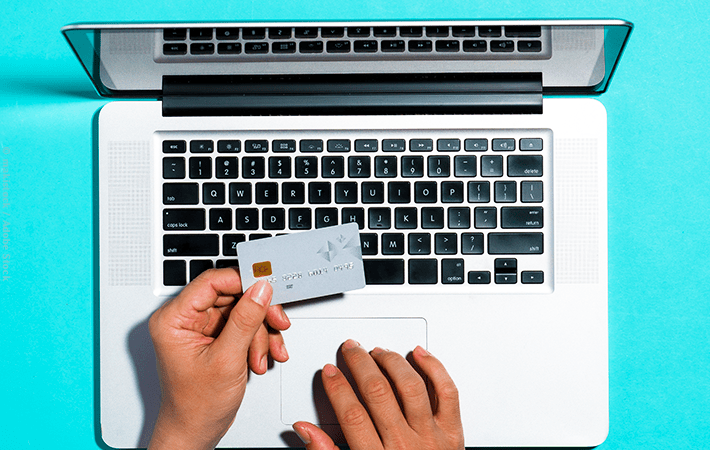This post may contain affiliate links. This means that if you click and make a purchase, I receive a small commission at no additional cost to you. I only recommend products I use and love, or that I would recommend to my mom or best friend. Please see the disclosure statement for additional information.
Shopping for clothes and decor is great – until it starts cluttering your house and draining your bank account. Learn how to stop overshopping and curb impulse buys by taking simple actions.
Want to guess how many pairs of black pants are hanging in my closet?
The number is high enough to cause red heat to creep up my cheeks.
The truth is, I used to have a bad shopping habit.
Bad as in, I probably had my own line on J.Crew’s quarterly income statement.
Bad as in, managers at my favorite stores would call me to remind me of upcoming sales. They knew I couldn’t resist.
One day, I realized also that I couldn’t resist a sale. So I did something about it.
Overshopping wreaks havoc on your finances, wardrobe, and goals. If you find yourself dropping money on stuff you know you don’t need like I did, there’s hope.
I’ll show you how to stop overshopping by assessing your own needs, creating new habits, and putting spending safeguards in place.
Before we jump in, Let’s make something clear. Shopping can be a serious psychological addiction, much as gambling is. If you think you may be addicted to shopping, seek professional help.
How Overshopping Hurts You
The first step in how to stop overshopping is to examine the effect it has on your life.
When you’re in the overshopping moment, it’s easy to think, “Oh, it’s only $50,” or whatever amount.
However, impulse shopping adds up quickly, even for things that cost only $5 or $10. As a result, it’s important to understand exactly what those “harmless” little purchases are doing to you.
Overshopping Wastes Your Money
Hate your stove? Need a new roof? Tired of wide-eyed fear every time you go to check your account balance or pay your bills?
Overshopping robs you of the financial resources to cover expenses and build financial confidence. You waste money on things you don’t need, and you suffer from financial stress as a result.
Overshopping Creates Clutter
Remember my multiple pairs of black pants? They’re crowding my closet as a result of impulsive overshopping.
Buying clothes and other items you don’t need and won’t use adds to the clutter in you closet and home. That means less space for the items you do use and love. If you’re wondering how to stop overshopping and you hate clutter, you just found your motivation.
Overshopping Derails your Financial Goals
If you’re saving up for a new car, a vacation, or retirement, impulse shopping can take away extra money that could have been put toward those goals. It can also derail them altogether. As a result, it’ll take you longer to reach your financial goals – if you reach them at all.
I’ll be honest – I have pulled money out of savings or from a vacation fund in the past to pay for impulse buys I didn’t need. I still feel terrible about doing it! And if you’re overshopping with a credit card, you’re adding debt and interest on top of bringing things home you don’t need.
Overshopping Causes Feelings of Guilt and Embarrassment
This is probably obvious, but yeah… no one feels good about overshopping. Maybe you’re mad at yourself for doing it (again). You might even be embarrassed to admit you overshop or spend more than you can afford.
Not to worry, friend. Now that we’ve talked about all the icky ways overshopping wreaks havoc on our lives, we’re going to talk about how to stop overshopping.
How to Stop Overshopping
As I’ve said before, I used to have a problem with overshopping. For me there were 3 key steps in determining how to stop overshopping, and I’m sharing them with you today:
- I assessed my needs,
- Created new habits, and
- Put spending safeguards in place
Assess Your Needs
The first step in how to stop overshopping is to assess your needs. This will help you understand what you actually need to shop for, and how much you can afford.
Create a Budget
You maybe don’t want to hear this, but budgeting is important.
Without a budget, you won’t know how much you can afford to spend on clothes (Or whatever you tend to overshop on). And without a set spending limit, you might just keep on shopping as long as there’s money in your account. Not good!
Creating a budget is a whole other post in and of itself, but here are a few good budgeting resources:
- Rosemarie at The Busy Budgeter has a detailed post on how to create a budget.
- Lena at What Mommy Does has a quicker budget tutorial and a free monthly budget spreadsheet, too.
Start budgeting monthly, if you haven’t already. Oh, and resist the urge to give yourself a giant allotment for clothes or whatever you tend to splurge on. It’s generally recommended that about 5% of your income is dedicated to clothing. While you’re at it, start putting that extra money into savings.
Assess your Belongings for Things You Need
The point of this post is not to stop you from buying anything at all. There may be things you legitimately need or are planning (responsibly) to purchase.
As a result, it’s important to figure out what those things are, get them on a list, and stick to that list when you’re shopping.
For example, are there wardrobe essentials you’re missing? “Essential” doesn’t mean it’s something you feel you can’t live without!
Maybe your go-to denim skirt no longer fits. Or you might be in need of some basic black flats that you can wear to work and on the weekends. These are completely different than seeing and buying something because you like it or because it’s a great deal.
If you tend to impulsively buy decor, create a list of all the decor pieces you’d like to find, such as “mirror for entry” or “centerpiece for mantle.”
Bottom line – if it isn’t on the list and you don’t have money in your budget for it, don’t buy it.

Establish Spending Safeguards
Look, I get it. Sometimes you can’t help yourself in the moment, no matter how much you know you shouldn’t be making that purchase. So, the next step in how to stop overshopping is to establish some spending safeguards.
Reduce Communication with Retailers
One of the most important steps in how to stop overshopping is to break up with the marketing teams of your favorite retailers. Once they have your email address, they won’t leave you alone!
They start cyberstalking you with emails about sales and items you abandoned in the cart on their website, retargeting ads, and paid advertising posts on social media.
Let’s give those bozos the retail equivalent of a restraining order by taking these steps:
Unsubscribe from their emails
All marketing emails are supposed to have an unsubscribe link (Usually hidden way at the bottom). Click it and don’t look back. You can even block their email addresses, if needed.
Combat Retargeting Ads
You might be wondering what a retargeting ad is.
Have you ever looked at a product on a website, then noticed an ad on the internet or on social media for the EXACT same product? That’s a retargeting ad.
Companies use cookies in your web browser to figure out which of their products you’ve been looking at, then buy ads on websites and social media to show the product to you again, hoping you’ll click and buy. It’s an overshopping disaster!
The good news is, you can stop many retargeting ads by clearing the cookies in your browser. To find out how, search online for “clear cookies + Google Chrome” or whichever browser you use. Then, clear cookies after you visit a retailer’s website.
Unlike/Unfollow Retailers on Social Media
Like with email, retailers will use social media to show you their products and inform you of sales, enticing you to click over to their website. Getting rid of those messages is as easy as unliking or unfollowing their social media account
Even if you unfollow a retailer on Facebook, for example, you may still see a retargeting ad in the form of a sponsored post from that retailer. Suffice it to say that it can be much more difficult to stop retargeting ads on social media. If you resist the urge to like or click on the post, they usually stop retargeting you eventually.
Tell Retailers to Stop Sending Snail Mail
A surprising number of retailers still send catalogues and coupons through traditional mail. And once you’ve made an online purchase, you’ll start getting them.
Call or email each retailer’s customer service department and tell them to remove you from their mailing list.
Make it Harder to Complete a Purchase on Retail Websites
Do you have address or payment information saved in your retail website accounts?
Allowing retailers to store that information makes it easier for you to make a purchase… and that’s exactly why they store the data for you. It can also put your personal information at risk in the event of a data breach.
Delete your billing and shipping addresses, as well as stored payment information, from your accounts on retail websites. If you can delete your entire account on the website, you might want to do that. Avoid creating accounts on retail websites in the future – most will allow you to checkout as a guest.
Limit Access to Payment Options
Another important step in how to stop overshopping is to limit your access to means of payment. This not only keeps you from making quick impulse purchases, it adds an additional barrier to completing any purchase. As a result, you have more time to think through buying decisions.
- Before you head out to shop, withdrawal only enough cash to cover the items you plan to purchase (Not impulse buys!). Leave your credit/debit cards at home.
- Store your purse or wallet in an out-of-the-way location when at home or at work. As a result, you won’t have payment methods at your fingertips when shopping online.
- If you have your credit/debit card numbers memorized (I am totally guilty of this), ask your bank to send you a new card. (You might want to ask if any fees are involved first.) Don’t memorize the new card number!

Create New Habits
An important step to conquering overshopping is to examine why you do it in the first place. Once you have that figured out, you can create new habits to prevent impulse purchases.
As I thought about the reasons I overshop, I started to realize that it wasn’t buying the products that I enjoyed. What I enjoyed was identifying a good deal. Maybe the same is true for you.
Once I figured this out about myself, I did some experimenting. As a result, I found some ways to allow myself to enjoy the thrill of the deal hunt, without dropping bank on the great deals I’d found.
Online Shopping
Despite doing everything above, you might still find yourself adding impulse buys to an online shopping cart.
If none of the items in your online cart are on your list of needs from above, take a few moments to relish in having scouted out some amazing deals. Then, safe in the knowledge that those deals aren’t good enough for your and your life right now, close out of the browser window and clear the browser cookies to avoid retargeting ads.
Do something you enjoy to take your mind off those purchases. Have a cup of coffee, call your best friend, watch an episode of your favorite show on Netflix. After all, you just took a big step toward kicking your overshopping habit, and that deserves to be rewarded!
If your online cart has a mix of things on your list of needs, plus impulse buys, walk away for an hour. Once you return to the online cart, the allure of the impulse buys will probably be gone. Delete them from the cart and buy your needed items. I do this all the time, and it works like a charm.
In-Store Shopping
Learning how to stop overshopping in stores is similar to doing so online.
I have a tendency to see something in a store I think is cute, and pop it in my cart. That used to break the bank!
But like I stated above, I started giving myself kudos for having found a great deal, acknowledged that it wasn’t anything I needed at the moment, then put it back on the shelf. And it actually works!
Don’t be ashamed to put things back on the shelf. Deciding you don’t need something is a good thing. Think of it as giving yourself a discount on the money and storage space you’d be giving up if you overshopped and brought those things home!
I’m notorious for wandering around in Target for an hour or more as I let my impulse items percolate, eventually putting pretty much all of them back. My family start to lose their patience eventually. But it’s a small price to pay for not having to pay the price of an impulse buy!
How to Stop Overshopping: Conclusion
Overshopping is an easy habit to fall into. With a little planning and a few simple fixes, you can help yourself kick impulsive spending tendencies and reclaim your money and closet. Here’s a quick recap of what we covered today:
- Create a budget so you know exactly how much you can afford to spend when shopping
- Create a list of wardrobe or household items you need; don’t buy anything that isn’t on the list
- Reduce communication with retailers by unsubscribing from their emails, unfollowing them on social media, and cancelling coupon/catalog mailings
- Clear cookies in your web browser to reduce retargeting ads
- Remove stored credit card and address information from retail websites; if possible, delete your account on those websites
- Plan what you’ll buy before you go shopping, withdrawal only enough cash to cover your purchase, and leave credit/debit cards at home
- If you shop online, store your purse or wallet in a remote location, like in a closet, so it’ll be harder for you to get the credit/debit card to complete a purchase
- If you have your credit/debit card number memorized, request a new card from your bank
- Whether you shop in stores or online, delay your purchase as long as possible; then, remove items from your cart that aren’t on your list of needs
- If you enjoy the thrill of finding a great deal, give yourself kudos for doing so; acknowledge that the item isn’t right for your life at this time; and remove it from your cart
- If you feel addicted to shopping, you might have a health condition; seek professional help
Have you ever had issues with overshopping or impulse buying? How did you overcome it? Let me know in the comments below!
P.S. – The number of black pants hanging in my closet? 11. Don’t even get me started on navy blue…
